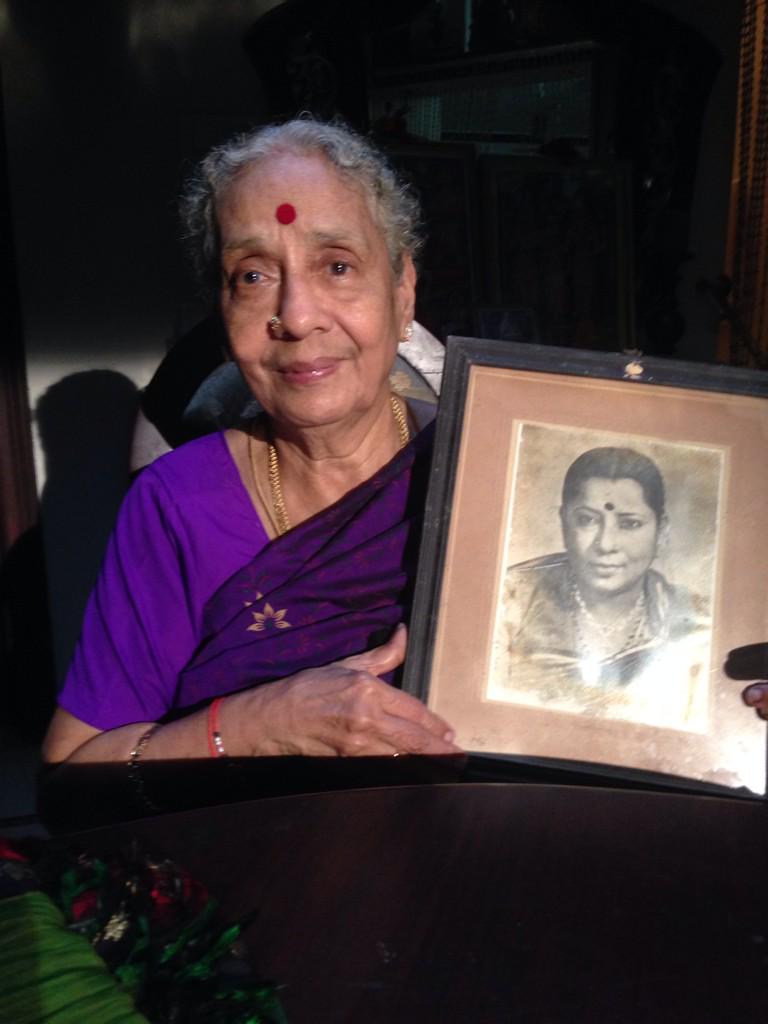Diwali Day. October 1931.
Madras Central Railway Station. The movie reel box had arrived from Bombay by train. Thousands of people crowded the busy Wall Tax road through which the reel box was taken to Kinema Central- where the movie was to be screened. People all along the roads showered flowers, broke open coconuts on the roads, showed ‘arti’ and burnt incense sticks, welcoming the reel. “Watch for yourselves, the first talkie featuring your favorite star TP Rajalakshmi dance and sing in Tamil and Telugu” screamed the posters all along and “The famous drama artiste TP Rajalakshmi for the first time in a talking cinema”, announced loudspeakers in cars and automobiles. The first talkie of Tamil Cinema, Kalidas, rested squarely on the tender shoulders of a girl, who was barely 20, married at 7 and divorced at 11!
Born in a small village called Saliyamangalam near Tanjore in 1911, Rajalakshmi was blessed with an amazing voice and cursed with poverty. The father Panchapakesa Iyer was a temple priest and the family practically lived off the temple offerings. Fearing the abject poverty that abounded, Panchapakesa Iyer married off the little girl when she was hardly seven years old to Sundaram of the same village. The issue of dowry cropped up and the poor priest was no match to the demanding groom side. The little girl, though married was left back in her maternal home. It broke the heart of the father that he jumped into a well and committed suicide.
The mother-daughter duo was now left with no means to survive in the village, with the groom turning his back on the bride. The mother decided to move to the city which she believed will provide a livelihood for them. With little money left, they walked all the way from Saliyamangalam to the nearest big city- Tiruchirapalli. They found shelter in a small shack. The little girl used to sing whenever she could and the neighbors who listened to the voice were spellbound. One of them suggested the mother take Rajalakshmi to a touring drama troupe nearby, so she could get a chance to sing and act. Those were the days when movies were hard to come by and people had drama as their sole entertainment. Luckily for her, legendary drama director and producer CS Samanna was camping in the city and Sankaradas Swamigal, the drama Mogul was accompanying Samanna.
When the ten-year-old Rajalakshmi auditioned in her booming voice, Samanna was reluctant initially, though he was immensely impressed with the voice. Dramas and drama artistes were hard to come by those days, especially the women. It was the men who donned the roles of women and children in the dramas. The “stree part”, “bala part” were all played by men and the owners found it easy to administer the all-men team. It was very easy for all practical purposes like stay and food. When the little girl auditioned, though Samanna liked her charisma, he was skeptical of including a girl in his troupe. This is where Sankaradas Swamigal stepped in. “Mark my words, she is going to be the next big superstar of drama world”, he cajoled. Samanna finally gave in and signed up Rajalakshmi in his troupe. She was thus the first female actor in dramas, admitted at a pay of fifty rupees per month.
The actress was a magnet, pulling in the audience. Her signature song “Paranthu pongada vellai kokkugala” (Fly away White cranes) was a huge hit, its hidden meaning well understood by the masses. The Freedom Struggle was at its hardest phase then, with a huge following and Rajalakshmi’s patriotic songs were crowd pullers. The husband now suddenly woke up from his feigned ‘coma’ and divorced his wife, who was an “actress”. Obviously, his family’s ‘name’ was sullied. Rajalakshmi was eleven years old when divorced and she took it with calmness and peace. Divorced, ostracized by the caste to which she belonged to, she survived all the ruckus and emerged victorious through sheer grit and determination. She traveled all over the Presidency with the drama troupe and also ventured out on tours to Burma and Malaysia. She was signed up for silent movies, she acted as Madhavi in her first movie Kovalan. She acted in a handful of silent movies then, including Usha Sundari.

In 1930, she acted in a short movie called “Kurati paatum nadanamum”, where she danced in addition to singing all the songs. Producer-director Ardeshir Irani was quite impressed by the girl that he invited her over to Bombay, took a make-up test, and cast her in the first Tamil-Telugu bilingual talkie ever- Kalidas, that released in 1931. Though the movie was based on Tamil epic “Silappathikaram”, she sang “Gandhiyin Kairattiname” (The charka of Gandhi) and “Indhiyargal namakkul yaeno veen sandai” (Why we Indians should fight unnecessarily amongst us), two songs totally unrelated to the storyline. She sang the first hit song of Tamil cinema in this movie- “Manmadha baanamada, nenjinil paayuthada” (The arrows of Manmadha, the love God, pierces through the heart)
A slew of talkies then followed- Sampoorna Ramayanam, Valli Thirumanam, and Harischandra, to name a few. It was on the sets of Valli Thirumanam that she met her groom-to-be, TV Sundaram who acted as Narada. The movie was a super-duper hit and earned her the name Cinema Rani. The couple married soon and set up a home. Their daughter Kamala was born in 1936. Rajalakshmi was a prolific writer too and she penned her first Tamil novel “Kamalavalli endra Dr. Chandrasekaran” (Kamalavalli @ Dr. Chandrasekaran). Rajalakshmi ventured into production and direction in the same year, as she launched her own production house Sri Rajam Talkies and made her first movie Miss Kamala. Miss Kamala revolves around a young woman who is married off to a man against her liking by her family, as she is in love with another youth. But the husband when he comes to know of his wife’s liking marries her off to her lover!
Miss Kamala was the first Tamil movie directed and produced by a woman and the first movie made from a social novel. It is said she named her daughter born in the same year, after the movie Kamala. This was the first film where the audience saw the ‘radio’ on screen and the first movie with a ‘heroine kidnapping scene’! Rajalakshmi was way ahead of her times. She went on to write few more novels- Vimala, Mallika, Sundari, Vasanthika, Uraiyin Vaal, to name a few. In 1937, she acted in her next big blockbuster- Seemanthini, directed by Ellis Duncan. Videos of the movie being made are available with the West Virginia University archives now. Duncan had mentioned in his biography that Rajalakshmi was an excellent actress.

A staunch patriot, Rajalakshmi was totally involved with the freedom struggle. She continued composing and singing songs praising the struggle and was under the British radar all the time. She was close to S. Satymaurti, the Congress leader. As her contribution to the cause of freedom, she made the movie “Indhiya Thai” under her Sri Rajam talkies banner. The film was mauled by the British censor board and she was forced to change the name to “Thamizh Thaai”. Even then, the movie bombed in the box office due to the unscrupulous cuts. Rajalakshmi was not bogged down, she kept saying it was her contribution to the country’s struggle. She went on to produce hits like Madurai Veeran in 1939 and Sri Meenakshi Kalyanam.
She was also a staunch supporter of Periyar and his Self-Respect Movement. He used to call her his ‘sister’ and visited her house at Rajaratnam Street, Kilpauk. She was not a woman of empty rhetorics. She was someone who believed in what she wrote and did. She saved a girl child from the clutches of female infanticide and brought the child up as her own, took proper care, and married off the girl when she grew up, reminisces her daughter Kamala. She worked for woman’s emancipation and against practices like Sati.
When she was cast to act in the movie Nandakumar, which was remade in Tamil from Marathi, produced by Keshaorao Daibar, she refused to wear a strapless blouse that exposed skin. Marathi actress Durgabai Khote had acted in the original Marathi version wearing the same without even a murmur. Rajalakshmi threatened to quit the movie and the producers finally arrived at a compromise. They agreed to let her wear a 1930s model Poona Jumper blouse and act. That is when the lady budged!

Steadily she started losing chances to act and was content in caring for her family. In 1950, she acted in her last movie “Idhaya Thai”, donning the role of the mother of the protagonist. The movie bombed as people couldn’t bring themselves to see an aging Rajalakshmi. Her successful career came to an end then. “My mother was against me or anyone from our house taking up acting”, says her daughter Kamala. Rajalakshmi had acted in 25 movies. She died in 1964 of low pressure.
“Marriage is a contract where men and women agree in toto to the union. We don’t object when men go against this contract and marry many women. Why is it so wrong when a woman marries a man of her own choice? Should she not have that freedom?”- TP Rajalakshmi, Kamalavalli, 1936.
Author

Nivedita Louis
Nivedita is a writer, social and feminist historian. She works on forgotten women, subaltern literature and Christian heritage. She conducts heritage walks and tours through unchartered territories of the city.



